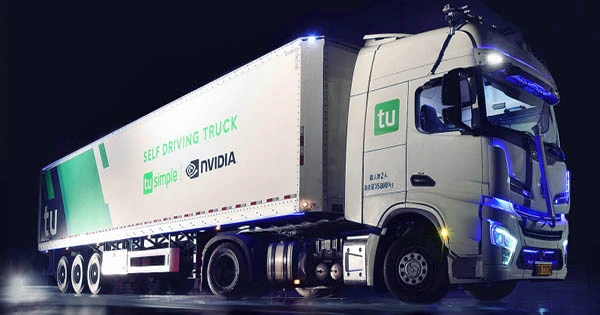According to the firm, autonomous trucking startup TuSimple has completed its first autonomous truck drive on open public highways without a person in the vehicle. TuSimple’s Autonomous Driving System (ADS) navigated 100 percent of the 80-mile run without human intervention between a railyard in Tuscon, Arizona, and a distribution center in Phoenix, marking a milestone for the company, which aims to scale its technology into purpose-built trucks by 2024, according to the president and CEO Cheng Lu.
TuSimple’s one-hour and 20-minute trip along I-10, a key freight route that extends from Los Angeles, California to Jacksonville, Florida, fits neatly into the business’s future commercial activities, Lu said, in part because the company has parking facilities in Tuscon.
While the truck did transport pre-loaded items, the pilot run’s focus was on technology rather than a business. The business has completed 1,800 runs totaling 150,000 miles on this stretch of highway over the previous year and a half and aims to continue testing its driver-out program until 2022.
“Having full commercial-scale deployment is the inevitable next step and a significant aspect of this progression of our technology,” Lu told TechCrunch. “We need to be able to have all of the features that you can run without a driver on the road on one route and one type of vehicle, as well as the degree of reliability that’s necessary to remove the driver out. That is a considerable amount of R&D engineering labor. It is no longer a research experiment when you can show that you can safely remove the driver, even on a single commercial operator route. It’s engineering work, and it’ll take time, money, and a lot of hard effort from our team, but we’re certain that we’ll be the first to deploy fully autonomous vehicles on a commercial scale.”
The self-driving trucking business is not the first to accomplish driverless operations in Arizona, a state with favorable AV testing and commercialization legislation that is vying to become the leader in autonomous driving. Waymo, Alphabet’s autonomous driving division, has been operating driverless robotaxis in Phoenix since October of last year.
Highway driving, according to Lu, is more difficult than city driving, where response times and skills to drive the car safely are easier due to the lower speed limitations. “The issue with a truck is that it drives on the highway at considerably quicker speeds, like 65 miles per hour, and it’s substantially heftier and harder to manage, harder to break,” he added. “The safety and reliability consequences are significantly larger.”
TuSimple’s pilot shows that the business has achieved Level 4 autonomous technology for at least this operational design domain, which SAE defines as a system that can drive itself totally without the need for human intervention. TuSimple’s Class 8 truck was on the road between the hours of 9 p.m. and midnight, which Lu claims is when many trucks are really on the road.
According to the business, the ADS traversed surface streets, traffic lights, on-ramps, off-ramps, emergency lane vehicles, and highway lane changes in open traffic. Unmarked police vehicles trailed the truck for approximately a mile as a safety measure in case it came to an emergency stop. TuSimple also sent a survey vehicle five miles ahead to search for abnormalities, as well as an oversight vehicle a half-mile behind that might put the autonomous truck in a low-risk situation. “I think public opinion and our comfort with autonomous trucks on the road is vital for this business to move forward, and that takes time to create,” Lu added. “It’s critical to have a lot of safety procedures in place before taking that initial step.”
















